In the seven years since my first radio contacts, I now have a process for logging amateur radio contacts. However, it wasn’t until I started working remotely more that I appreciated how logging amateur radio contacts accurately is complicated. This inaccurate logging was the cause of much frustration during the final throes of my completing the ARRL Triple Play where, for example, the Parks on the Air person I worked “in Michigan” would log their home state (not Michigan). I now understand why.
The fundamental problem, I think, is there are multiple sites (Logbook of the World, QRZ, eQSL and ClubLog), each which has its own particular extra steps that you’re supposed to stumble upon. I hope to clear this up, both for myself, and the other ham who wants to help you earn credit for (some goal), but was simply unaware of the extra hoops to jump through.
Logbook of the World
Let’s start with the Big Kahuna, ARRL’s Logbook of the World, which as I write this, has been down two weeks with no estimate time of recovery or useful detail other than:

LotW conceptual overview
The model is logically represented by the image below where there are certificates used to “sign” the log as authentic (and upload it to LoTW and QRZ), and station locations with the specific location information I’ve operated from.
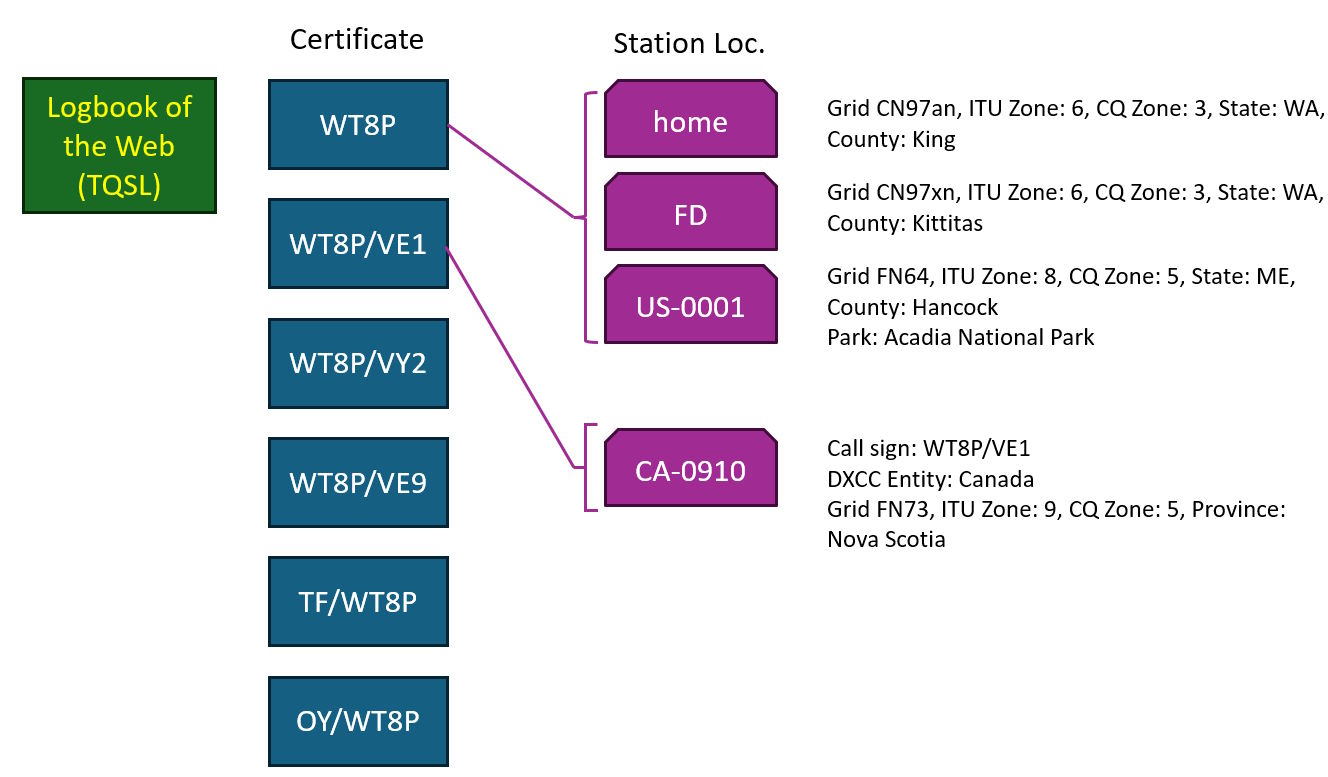
Getting your first certificate is a process beyond the scope of this discussion, so I’ll assume everyone has at least the first. For the conterminous US, I can use WT8P. However, if I want to be accurate, I’ll should create a station location in TQSL to note each location’s grid, county, state, ITU Zone, CQ Zone and, if applicable, park and (Island On The Air) designation. In the screenshot below, I had done these for Field Day, three US POTA sites (before K-0001 was renamed US-0001), and my home:
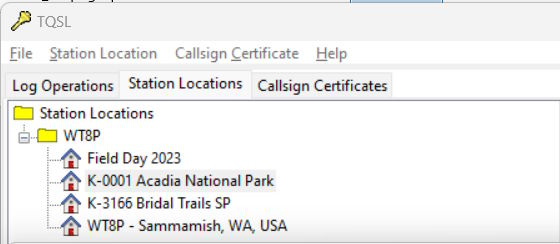
Create a station location
If I were going to operate in a new park, I simply Add Station Location in TQSL and fill out the information. For example, suppose I’m headed to Manhattan Project National Historical park in Los Alamos county, New Mexico. I’d look up some of the information on Parks on the Air, then fill in the details in TQSL using my WT8P call sign/certificate:
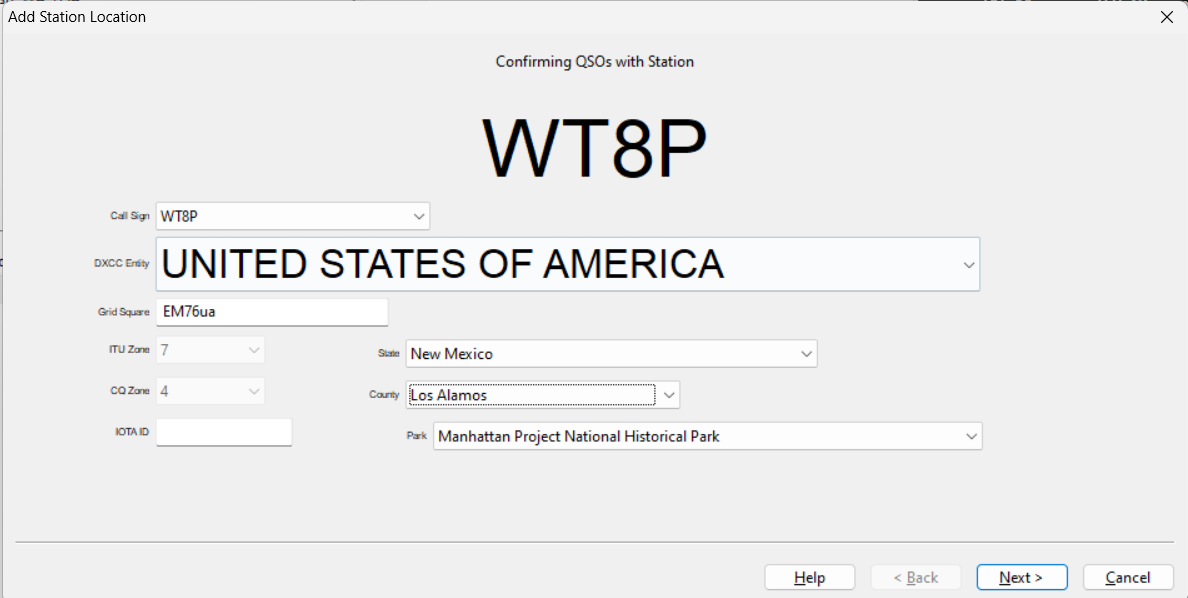
When I log these, I’d choose this “station” so anyone who worked me would then get credit for New Mexico. This is the step that most POTA folks are omitting, if they log at all. Ideally, they’d create a “station” for every park activated, then upload the logs using this as the reference.
Operating outside of your “DXCC” entity? Request a certificate
Things get a little more interesting when I operate outside of the conterminous United States. During my trip to the Canadian Maritimes, I planned to operate in Nova Scotia, New Brunswick and Prince Edward Island. Because Canada and the US have reciprocal operation privileges, there was no specific license or permit required, but I was obliged to identify as WT8P/VE1, WT8P/VE9 and WT8P/VY2, respectively. To log them accurately, I request a new certificate for each in the TQSL program. For the first four certificates one has, the request is handled via an auto-responder. I promptly received the certificate that I could import to TQSL. (For subsequent certificate requests, there is a delay as someone has to approve their creation. Thus /VE4, /VE5, /VE6, /VE7 had a three-day delay. Not a big deal.) Adding Iceland (TF/WT8P) and, last month, Faroe Islands (OY/WT8P) was the same process.
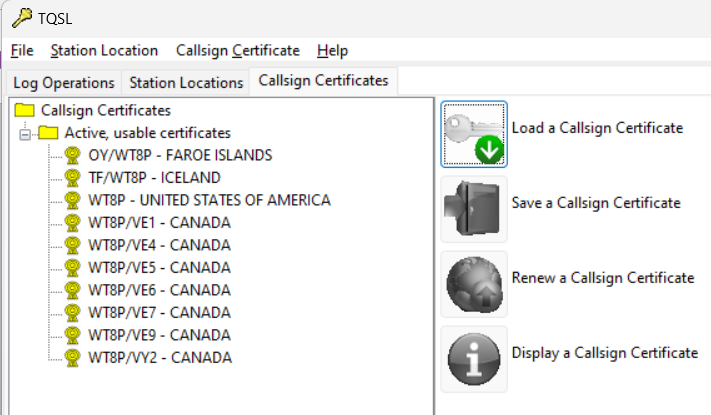
One caveat when creating certificates: Do not set a password. This will just add an unnecessary and often confusing step in your process. We’re dealing with QSL logging, not securing Fort Knox, so one is overkill for most purposes.
Adding a new station location with a new certificate
Once I have a certificate for an entity, the process for adding a station location is the same. For example, if I activate the lone POTA in the Faroe Islands, I use my OY/WT8P call sign and fill out the information:
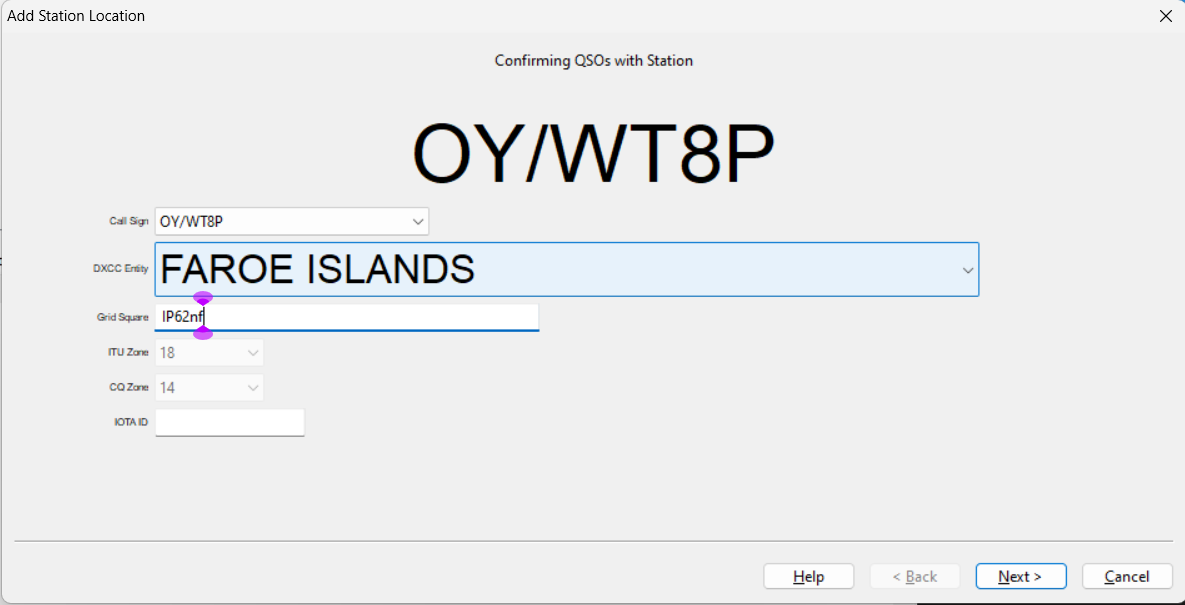
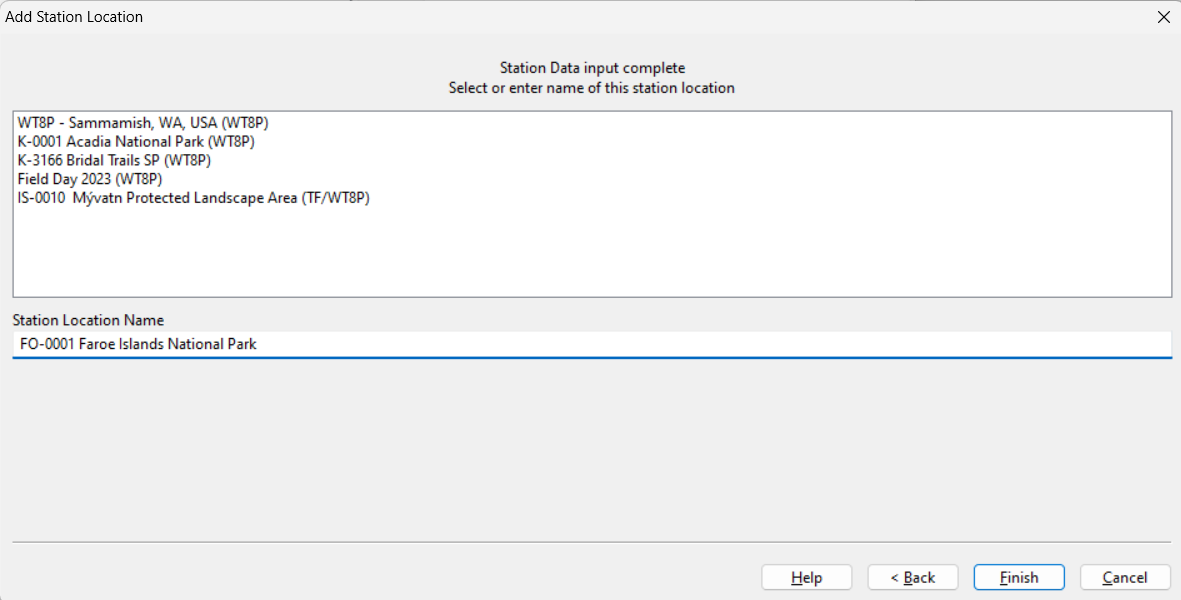
QRZ.com
The other important site is QRZ.com since it’s very common and can do data interchange with Logbook of the World. Specially, any LoTW confirmations count as QRZ confirmations, but not the opposite. Its barrier to entry is lower, can be used as a call sign lookup, and there’s a separate set of awards one can work for.
As far as I can tell, it is perfectly fine importing the Logbook of the World data as it stands. Thus, you don’t explicitly need to do anything to your profile for a new park on the air other than log it with the information you have. However, because QRZ is often a lookup source, and seems to default to a single profile, this will generate a lot of discontinuities that affect other users.
Add the special suffix/prefix:
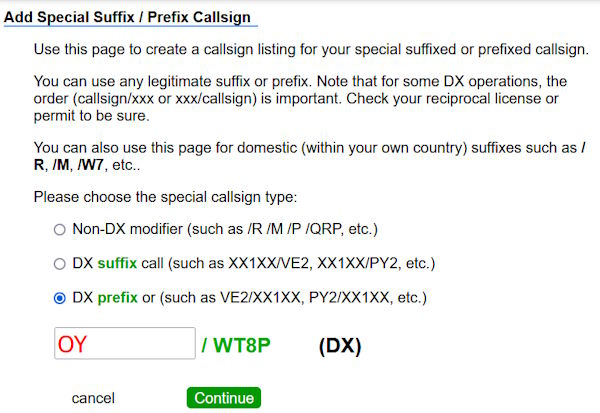
There’s no special setup for roaming station location, but if you have additional certificates, there are a few steps. First, navigate to the manager section, and add the secondary call sign. For example for the Faroe Islands, I will use a DX prefix of OY/.
One thing to be aware of is when you do this, it’s broadcast to others, which is not necessarily a bad thing, just surprising. Shortly after creating this, I received a request for info for the DX Newsletter as well as an offer from someone to manage paper QSLs.
Add contact information
It will then send you to another page with call sign information. I didn’t screenshot this the first time, but it’s identical to what I see on edit. Omitting the personal information (my name, address, email):
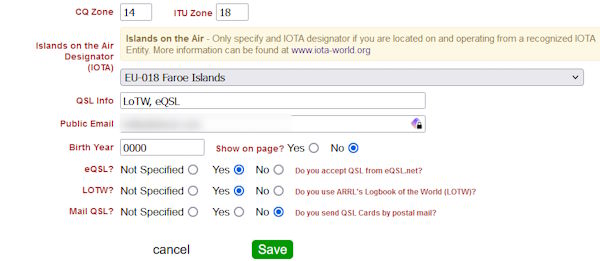
It should now appear in the Secondary Callsigns block of the User account information.
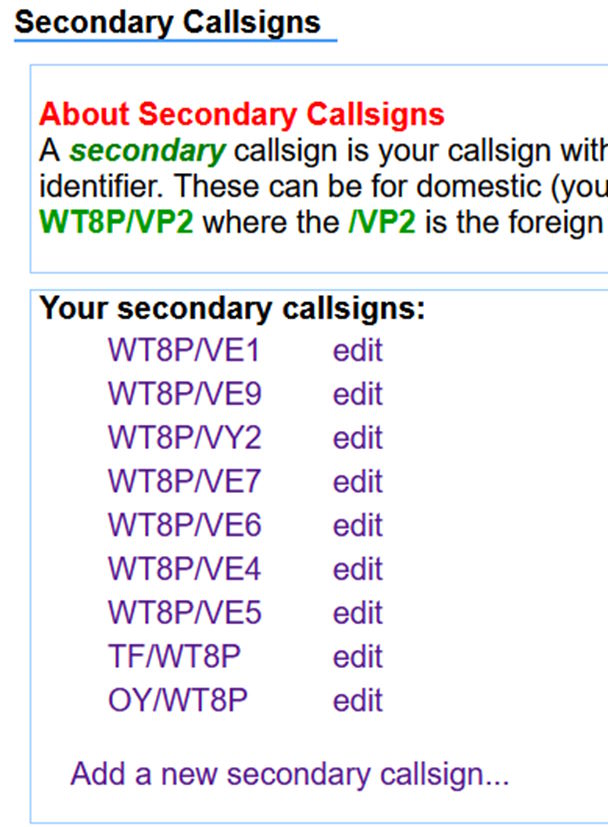
Add logbook start and stop dates
Before the “Logbook” is available in QRZ, you will also need to specify some information. I picked the same start date that I used for the certificate. For the end date, it seems any date after the time there is fine, so I picked a sufficiently far in the future 2043. I’ve also filled in the various zones, grid, and IOTA blocks used for QRZ’s purposes – most of these are information that we had from TQSL earlier.
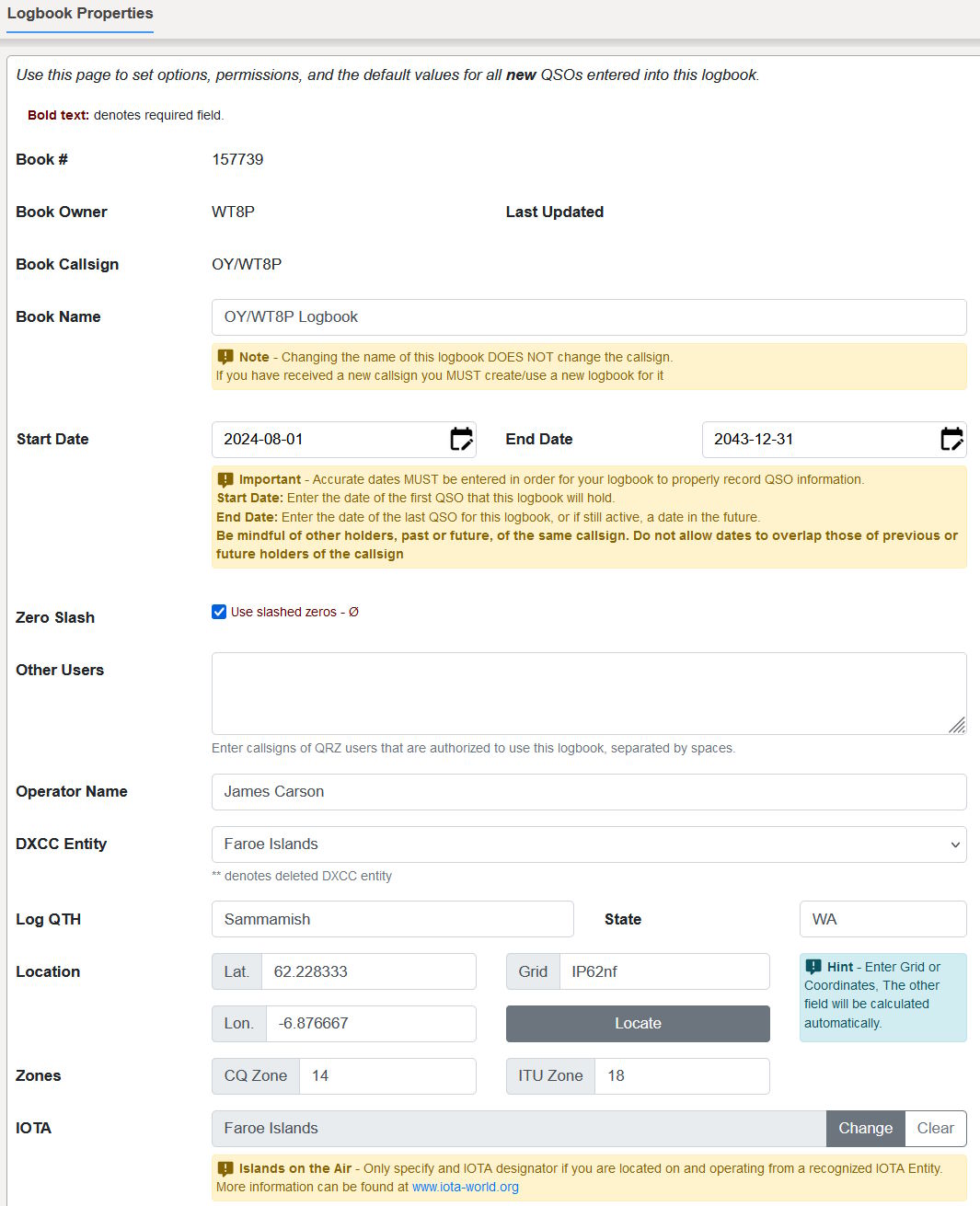
Add your LoTW certificate
Finally, to enable data exchange with Logbook of the World, you’ll need to upload your certificate on the specific logbook page. In the drop-down, I would select OY/WT8P Logbook. On the bottom is this box:

Because Logbook of the Web is currently Tango Uniform (“tits up” aka “dead”), I can’t demonstrate this step easily, but the document on QRZ is surprisingly useful. But briefly, in TQSL, one exports the certificate as a *.P12 file. This is then imported into QSL.
eQSL
I will come out and just say that eqsl.cc is frustrating for the Parks on the Air user or any temporary operation. While its configuration section supports the concept of station locations, it disallows any temporal overlap. Rather, one has to chain together entries with a call sign existing in a specific location (county, state, country, and grid square) during a period of time. In other words, every time I did a POTA, I’d have to create a new entry and simultaneously expire my home location, then repeat it when back home.

The same rigid data structure applies to DX entities. When I was creating my /VE1 so I could upload the logs, I mistyped the grid and it rejected all of the uploaded QSLs. Because you cannot edit a location, I had to expire the existing /VE1, create a new one (with the matching grid) and re-upload those call signs.
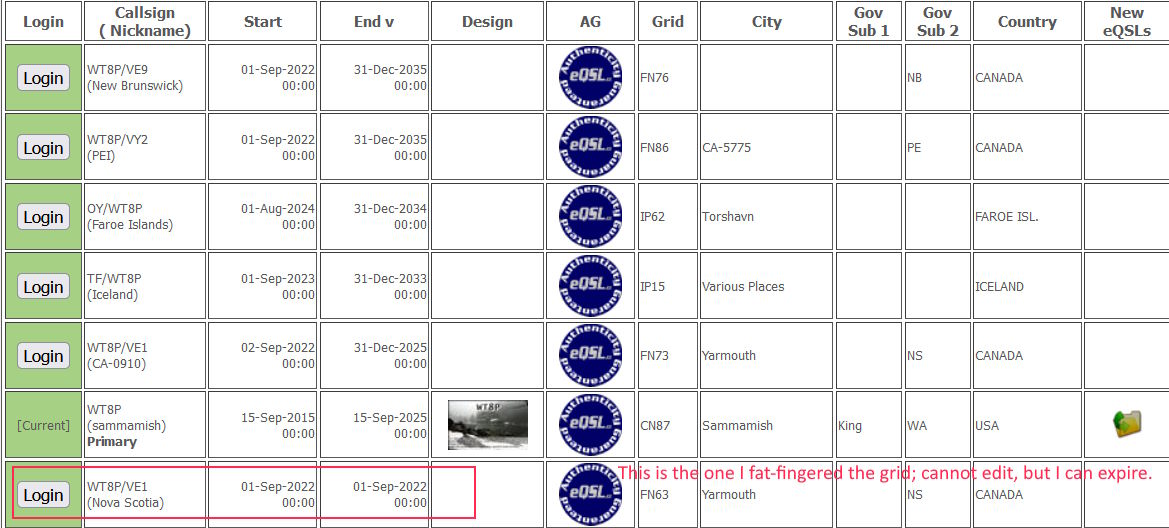
That is too much busy-work. So, I apologize if any of you happen to be using eQSL.cc for awards, you’re going to get what you get.
Clublog
After getting so frustrated with eQSL.cc, I was pleased that Clublog is very easy. Click on Settings -> “Callsigns” and add your new call sign:
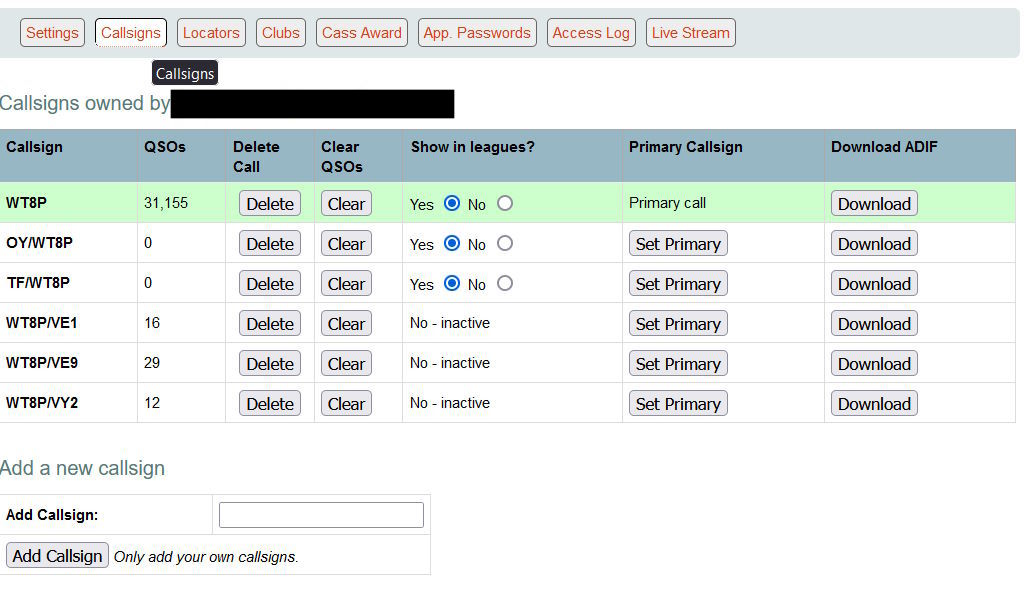
When uploading them, just specify which call sign the entries pertain to. Easy Peasy.
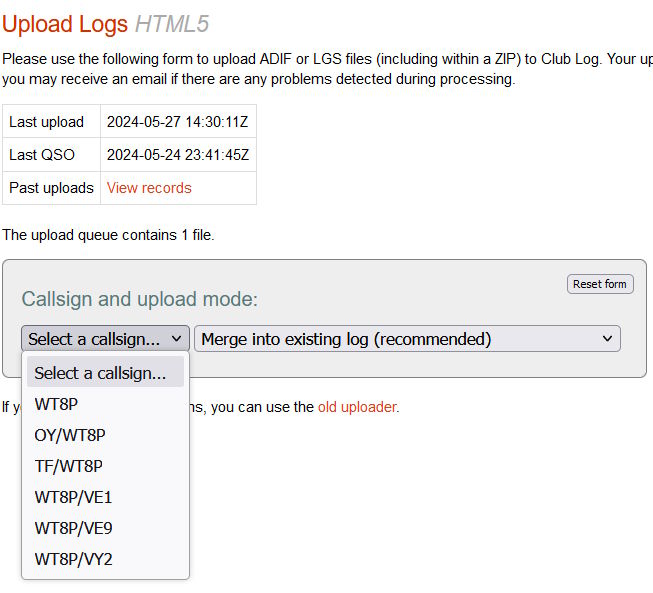
What about those other boxes?
If I’m doing a Parks on the Air activation, I can add additional call signs here.

But for my primary, it’s a joy to use after wrestling with eQSL. I can upload an ADIF-formatted file (an XML-style format that can have arbitrary additional fields) from either the mobile app (Ham RS) or desktop (N1MM+), then load that directly to the site.

The lone SOTA (summits on the air) I did was Acadia National Park, and also accepts an ADIF. While the hiking up the peak appeals to me, I’m just not serious about it to warrant spending more time. I will occasionally work someone on SOTA and try to log a spot to the site if I can remember the URL.
If I’m doing a contest, I will also upload something called a Cabrillo-formatted file to the contest site so it “counts” for the other person. Cabrillo-formatted documents have a long preamble, though their actual “logs” are simple lines. I used to get really worried about getting the data correct, but now rely on the contesting program N1MM+ to just magically export one on command.
I’ll also post a summary to “3830scores,” which is a self-reported leader board, but is also useful for seeing how you did over time.

The QRZCQ block is something I used when I first started out, but decided was largely a complete waste of time. I had found its data to be somewhat stale, but what drove me away was how terrible it was at removing duplicates from logs. I also didn’t see much in the way of other hams confirming contacts.
HamQTH, aka Ham365.net, has a log, but also provides some useful integration that lets you upload between sites.
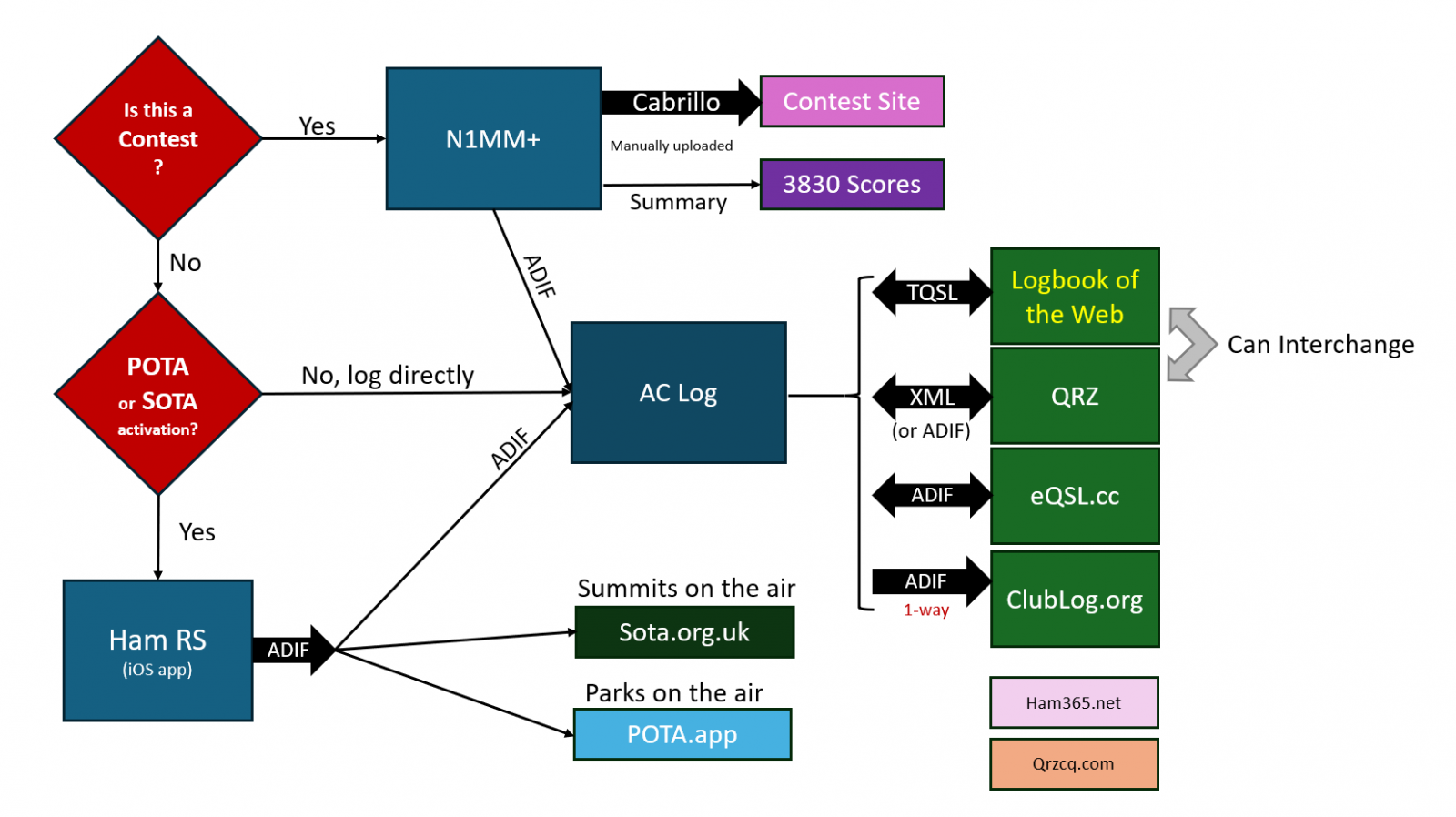
Sheesh!
‘Conterminous’. Lol, had to look that up!